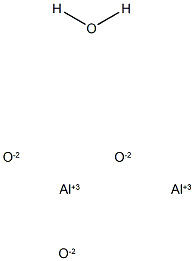Chemical Properties
Aluminum is a combustible, light, silverywhite, soft, ductile, malleable, amphoteric metal
Potential Exposure
Most hazardous exposures to aluminum occur in smelting and refining processes. Aluminum is mostly produced by electrolysis of Al2O3 dissolved in molten cryolite (Na3AlF6). Aluminum is alloyed with copper, zinc, silicon, magnesium, manganese, and nickel; special additives may include chromium, lead, bismuth, titanium, zirconium, and vanadium. Aluminum and its alloys can be extruded or processed in rolling mills, wire works, forges, or foundries; and are used in the shipbuilding, electrical, building, aircraft, automobile, light engineering, and jewelry industries. Aluminum foil is widely used in packaging. Powdered aluminum is used in the paints and pyrotechnic industries. Alumina, emery, and corundum has been used for abrasives, refractories, and catalysts; and in the past in the first firing of china and pottery.
First aid
If this chemical gets into the eyes, remove any contact lenses at once and irrigate immediately for at least 15 minutes, occasionally lifting upper and lower lids. Seek medical attention immediately. If this chemical contacts the skin, remove contaminated clothing and wash immediately with soap and water. Seek medical attention immediately. If this chemical has been inhaled, remove from exposure, begin rescue breathing (using universal precautions, including resuscitation mask) if breathing has stopped and CPR if heart action has stopped. Transfer promptly to a medical facility. When this chemical has been swallowed, get medical attention. Give large quantities of water and induce vomiting. Do not make an unconscious person vomit.
Shipping
UN1309 Aluminum powder, coated, Hazard Class: 4.1; Labels: 4.1-Flammable solid. UN1383 Pyrophoric metals, n.o.s. or Pyrophoric alloys, n.o.s., Hazard Class: 4.2; Labels: 4.2-Spontaneously combustible material, Technical Name Required. UN1396 Aluminum powder, uncoated, Hazard Class: 4.3; Labels: 4.3-Dangerous when wet material. NA9260 (North America) Aluminum, molten, Hazard class: 9; Labels: 9-Miscellaneous hazardous material.
Incompatibilities
Aluminum powder forms an explosive mixture with air and is a strong reducing agent that reacts violently with oxidizers, strong bases; strong acids; somehalogenated hydrocarbons; nitrates, sulfates, metal oxides and many other substances. Keep away from combustible materials.
Waste Disposal
Consult with environmental regulatory agencies for guidance on acceptable disposalpractices. Generators of waste containing this contaminant (≥100 kg/mo) must conform with EPA regulations governing storage, transportation, treatment, and waste disposal of Aluminum Oxide-Disposal in a sanitary landfill. Mixing of industrial process wastes and municipal wastes at such sites is not encouraged however. Aluminum powder may be recovered and sold as scrap. Recycling and recovery is a viable option to disposal for aluminum metal and aluminum fluoride (A-57).

